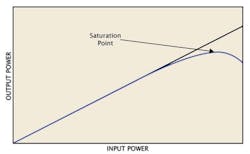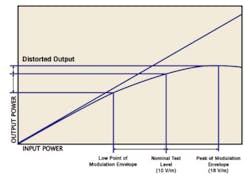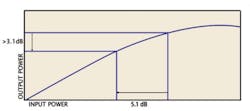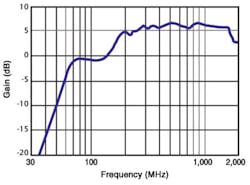Amplifier Considerations For the New IEC 61000-4-3
The third edition of IEC 61000-4-3, published in 2006, has mandated changes in some key areas that may require the replacement of your radiated immunity test amplifier. Along with extending the test frequency range to
6 GHz and better defining the calibration of the uniform field, the standard requires verification of the power amplifier linearity and output harmonics. As a result, some existing systems may fail to meet the new requirements because the amplifier in use is being run near saturation, and consequently, the modulated field is distorted.
Amplifier Linearity
A linear relationship exists between the input power and the output power over most of the operating range of an amplifier. However, as the power level rises, limitations in the supply voltage and current cause the output power to increase at a slower rate than the input. This initiates amplifier saturation.
The relationship between input power and output power starts to roll off and eventually reaches a point where increases in the input power cause no change in the output power�the saturation point. This point is the maximum power that can be supplied by the amplifier at a given frequency (Figure 1). Note that this saturated power level will vary with frequency.
Most amplifier suppliers use this saturated power figure to define the performance of the amplifier; however, in the case of IEC 61000-4-3 testing, this figure is not useful for selecting an amplifier or predicting compliance with the standard. Since the test requires that the RF test field is sine wave amplitude modulated, the input level is effectively increasing and decreasing around the nominal test level.
If the amplifier is operating at any point above the linear portion, the output-modulated signal will be distorted (Figure 2). For a true reproduction of the modulation envelope, the amplifier must be operating in its linear region.
Calibration
The IEC 61000-4-3 third edition requires that the extra power needed for modulation be taken into consideration. Previously, calibration was performed at the nominal test level and modulation added later, so the user may not have been aware that saturation was occurring. The latest version requires the user to show that the amplifier will be operating linearly, at the nominal test level, including the peak of the modulation envelope which is 1.8 times the nominal test level.
The new edition does not insist that the output modulation waveform be completely undistorted but requires that the amplifier be no more than 2 dB into compression at the peak of the modulation envelope. To show this, the chamber must first be calibrated with the actual equipment that will be used for testing and at a level 1.8 times the specified test level; that is, for 10-V/m test, the calibration is run at 18 V/m. This calibration produces a list of powers required at each frequency to achieve at least 18 V/m at one location in the uniform field with another 11 in the range of 0 to 6 dB above this level. Based on 16-point field uniformity, this requires that 75% of the points must fall inside the 0 to 6-dB range.
Subsequently, at each frequency, the calibration power level is generated by the amplifier, and then the signal-generator level is reduced by 5.1 dB. The amplifier power level must fall by at least 3.1 dB for the amplifier to meet the 2-dB linearity criteria and be considered linear (Figure 3).
Figure 3. 2-dB Linearity Criteria
If this cannot be achieved, improvement to the system is required, and it is necessary to operate the amplifier further down its gain curve. This may be accomplished in a number of ways:
� Reducing the losses between the amplifier and antenna using shorter or lower loss cables.
� Using a higher gain antenna.
� Improving the performance of the test chamber.
� Using a higher power amplifier.
Test Distance
The original issue of IEC 61000-4-3 defined the test distance as 3 meters from the uniform plane to the tip of a log periodic antenna or to the balun of a biconical antenna. This did not allow for combination antennas such as bilog.
Many users opted to set the distance to the phase center of a bilog antenna, which is approximately half way along the log periodic section. This meant that the balun and the part of the antenna responsible for transmitting the lower frequencies were approximately 3.5 meters from the uniform plane.
The third edition of IEC 61000-4-3 defines the test distance for combination type antennas as 3 meters to the tip of the antenna. This can increase the distance to the lower frequency radiating points of the antenna by up to 0.5 meter, which could add 1.16 dB to the power required at the lower frequencies or 30% more power.
Harmonics
All amplifiers will produce input signal harmonics. The level of these harmonics is dependent on the design and quality of the amplifier and will worsen as the amplifier approaches saturation.
However, the use of broadband combination antennas leads to a potential problem. Since the gain of the antennas typically increases rapidly between 80 MHz and 200 MHz, harmonics produced by the amplifier in this frequency range have a disproportionate effect in the field. See the sidebar Why Harmonics in the Field Are a Problem.
Rather than define the harmonics from the amplifier, the third edition of IEC 61000-4-3 requires the user to show that the harmonics in the field are at least 6 dB down from the fundamental. As most test laboratories do not have frequency-selective field measuring equipment, the standard allows the user to measure the harmonics from the amplifier at each frequency and then calculate the level in the field based on the performance of the antenna.
The harmonics from the amplifier must be measured at the level required to create 1.8 times the target test level as established during the field uniformity calibration. Again, it is important to ensure that the amplifier is not operating near the saturation level.
Figure 4 shows the gain vs. frequency curve of a typical combination type antenna. Comparing the gain at 100 MHz, 200 MHz, and 400 MHz, it increases by around 6 dB between 100 MHz and 200 MHz and by around 7 dB between 100 MHz and 400 MHz. Harmonics would need to be at least 12 dB and 13 dB, respectively, below the carrier frequency of 100 MHz to achieve a 6-dB margin in the field.
Most amplifier manufacturers specify harmonics of at least 20 dB down from the fundamental but only in the linear region of the amplifier. Harmonics will increase once the amplifier starts to go into saturation. See the sidebar Measuring Harmonic Content in the Field.
Software
As with all aspects of RF EMC immunity testing, the amount of data required to confirm the field uniformity, amplifier linearity, and harmonic performance makes the use of automated test software essential. For example, Teseq has recently released Version 4.00 of its Compliance 3 RF Immunity test software that allows a test laboratory to perform the field uniformity calibration at 1.8 times the nominal test level and then determines and records the linearity and harmonics at the test level.
Conclusion
The third edition of IEC 61000-4-3 better describes the test conditions and clarifies some previous anomalies. For instance, the test distance for combination antennas now is better defined, and the quality of the test field in terms of modulation shape and harmonic content is specified.
Although the purpose of the new standard was to create more consistency and repeatability in testing, it may result in some test facilities failing to meet the new requirements. Some improvements can be achieved by using better antennas or cables. But in some cases, there will be no alternative but to increase the power available from the amplifier.
About the Author
John Dearing is product manager for the Teseq range of RF broadband power amplifiers and Compliance 3 test software. Educated to degree level in electronic and electrical engineering, he went on to study RF and microwave electronics while working on the design and development of a range of TWTs for the defense industry. Teseq, Ashville Way, Molly Millars Lane, Wokingham, Berkshire RG41 2PL, U.K., +44 845 074 0660, e-mail: [email protected]
Why Harmonics in the Field
Are a Problem
Harmonics in the field are explained in detail in Annex D of IEC 61000-4-3 and fall into three main areas:
1. Inaccuracy of Test-Level MeasurementVirtually all field measuring instruments commonly used in EMC test laboratories are broadband devices; that is, they have no frequency selectivity and measure the total field present at all frequencies. If there is a significant harmonic content in the field, the measurement of the fundamental field strength will be incorrect.
Since there is no way of predicting if the various signals present will be added or subtracted due to phase differences, there is no way to make any corrections for this error. As a result, it is vital that the harmonic content of the field be kept to a minimum.
2. False Failures in the EUTWhen testing at a particular fundamental frequency, it is possible that the EUT could have susceptibility not at the fundamental but at the harmonic frequency. This would generate false failures at the fundamental frequency that could result in wasted time and money trying to design-out the problem.
3. Testing Intentional Receiver Devices
Commonly, when receiver devices are tested, the test software is configured to skip the intended operating frequencies of the receiver. However, if there are significant harmonics in the test field, high levels of the receiver�s operating frequency will be generated during the testing of the lower frequency range that could adversely affect the EUT.
Measuring Harmonic Content In the Field
Test EquipmentMost EMC test labs use only broadband measuring equipment such as isotropic field probes and power meters for immunity testing. To measure the harmonics, access to a frequency-selective instrument such as a spectrum analyzer or measuring receiver will be required.
The standard is not clear on how many harmonics should be measured. But from a practical standpoint, the lower-order harmonics will dominate, and broadband amplifiers will not generate significant harmonics beyond their defined operating frequency range.
For that reason, the laboratory would be required to have access to an instrument capable of measuring to at least the highest achievable test frequency. It is only required occasionally to verify the harmonics and would not be needed to run tests on a daily basis.
Antenna Calibration
In the past, it was not necessary to calibrate the antenna used for immunity testing. As long as the antenna was efficient at the required frequency, there was no need to know its actual performance because the system was calibrated as a whole.
Since frequency-selective field measuring instruments are not commonly available and expensive, the standard defines a method of determining the harmonic field strength by measuring the harmonic power from the amplifier and calculating the field strength based on the performance of the antenna at that frequency. As a result, the performance of the antenna must be determined.
September 2007




